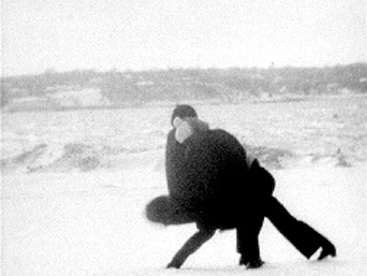
Born in 1936 à New York (US)
Lives and works in New York (US)

1968
B&w video, no sound, 16mm transferred onto DVD
durée : 5'37''
Year of Purchase: 2009
Wind is a Super 8 document which shows a group of people dressed against the cold individually or collectively performing different movements on a snow-covered and wind-battered beach. The static shots appear as a series of mini-performances: crossing the field of vision sideways with mirrors attached to one’s clothes; walking with one’s back pressed against one’s partner’s; forming and undoing human clusters, etc. These gestures, between ceremony and choreography, are made uncomfortable by the struggle against the natural elements and jerky by the jolts of the camera. The protagonists appear in a mechanical relation to one another, like puppets in the open air, or perhaps like penguins on ice. The surreal, burlesque impression is reinforced by the use of masks which reify faceless bodies in synch with the weather. Experimental slapstick. The more or less ordered movements seem at times to obey an organic model: connection and dispersion of units, assembly and disassembly of elements, or individuals subject to inner and outer forces and necessities within a living system.
In terms of form, this representation of an (animated) landscape with figures constitutes a free, dynamic fusion of artistic movements of the time: from experimental cinema and land art to performance. It’s a question of creating from nothing or next to nothing―which is a founding principle of minimal and conceptual art, and to an even greater extent, a principle of performance. Joan Jonas was close to the “postmodern” dance movement which formed, starting in the 1960s, around Judson Dance Theater in New York and aimed to demystify the choreographic process. It privileged the weight of the body, gravity, resistance, trivial gestures, as well as clumsiness and confusion, over the aerial, mastered, and unrealistic character of traditional ballet. It was a plastic practice of the body which united issues proper to conceptual art, dance, and sculpture. In Wind one can specifically discern certain principles reminiscent of “contact improvisation.” This technique was introduced by Steve Paxton who worked with force and energy exchange and, obeying an experimental, ludic, and joyful logic, privileged the falling of bodies over their liberation from gravity.
Jonas’s work, moreover, seems to be part of the dialectic between space and time, as was the work of Fluxus, John Cage, Bruce Nauman, Robert Morris, as well as of the film maker Jonas Mekas in his approach to recording the real. Within a historical perspective, the physical relations of energy and tensions, of fusion with nature and in situ movements, evoke pioneers of modern dance, such as Jacques Dalcroze, Isadora Duncan, and Mary Wigman (see, for example, her Wanderung, 1924): they are a way of animating the body and the mind at the same time, through simple, determined, collective movements which are rooted in a profane form of ritual, between motor-skill exercises and shamanism.
Overall, Joan Jonas’s experiments resonate with the spirit and the atmosphere of her time, placed under the sign of the collective, of curiosity, and of joyful community. The anonymity of the characters challenges the aura of the author and of the demiurgic performer. Instead, there develops gratuitous, experimental, disinterested work based on decisiveness, energy, and experience rather than on a search for a definite form. It belongs to a mercurial territory of artistic experimentation which liberated creativity in the second half of the twentieth century.
Guillaume Désanges